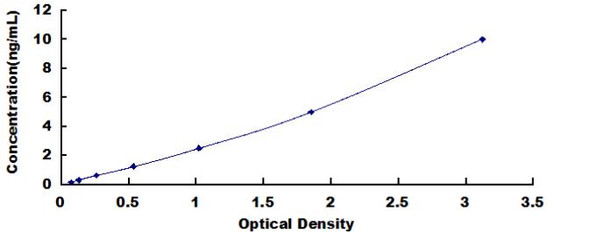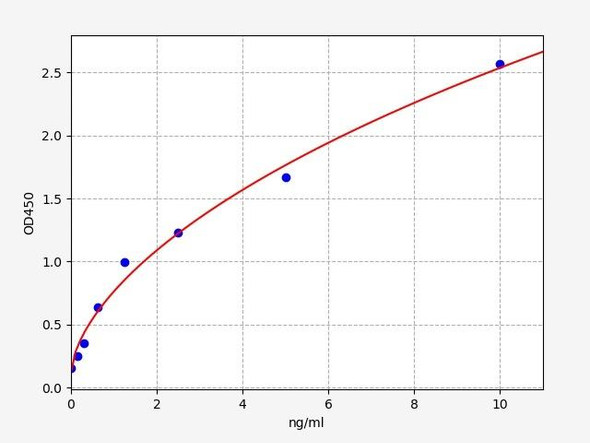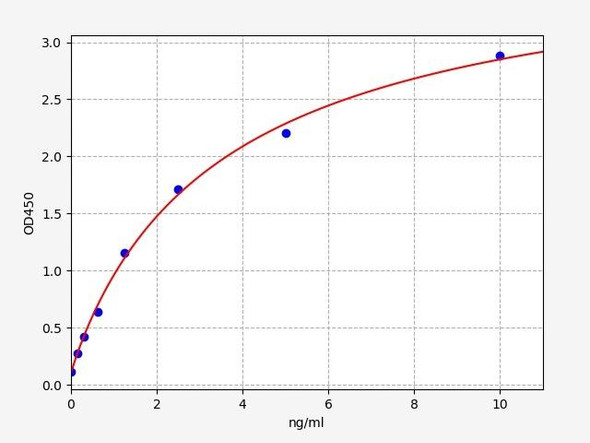Description
Human Tumor necrosis factor alpha-induced protein 3 (TNFAIP3) ELISA Kit
The Human Tumor Necrosis Factor Alpha-Induced Protein 3 (TNFAIP3) ELISA Kit is a cutting-edge tool designed for the precise measurement of TNFAIP3 levels in human serum, plasma, and cell culture supernatants. This kit offers exceptional sensitivity and specificity, guaranteeing accurate and consistent results for a diverse array of research applications.TNFAIP3, also known as A20, plays a key role in regulating inflammation and immune responses. Dysregulation of TNFAIP3 has been linked to various autoimmune diseases, inflammatory disorders, and cancer progression.
By accurately measuring TNFAIP3 levels, researchers can gain valuable insights into disease mechanisms and potential therapeutic targets.With its user-friendly format and superior performance, the Human TNFAIP3 ELISA Kit is an indispensable tool for scientists studying cytokine signaling, inflammation, and immune regulation. Don't miss the opportunity to advance your research with this innovative ELISA kit.
| Product Name: | Human Tumor necrosis factor alpha-induced protein 3 (TNFAIP3) ELISA Kit |
| SKU: | HUEB2710 |
| Size: | 96T |
| Target: | Human Tumor necrosis factor alpha-induced protein 3 (TNFAIP3) |
| Synonyms: | OTU domain-containing protein 7C, Putative DNA-binding protein A20, Zinc finger protein A20, TNF alpha-induced protein 3, OTUD7C |
| Assay Type: | Sandwich |
| Detection Method: | ELISA |
| Reactivity: | Human |
| Detection Range: | 0.312-20ng/mL |
| Sensitivity: | 0.1ng/mL |
| Intra CV: | 6.3% | ||||||||||||||||||||
| Inter CV: | 11.5% | ||||||||||||||||||||
| Linearity: |
| ||||||||||||||||||||
| Recovery: |
| ||||||||||||||||||||
| Function: | Ubiquitin-editing enzyme that contains both ubiquitin ligase and deubiquitinase activities. Involved in immune and inflammatory responses signaled by cytokines, such as TNF-alpha and IL-1 beta, or pathogens via Toll-like receptors (TLRs) through terminating NF-kappa-B activity. Essential component of a ubiquitin-editing protein complex, comprising also RNF11, ITCH and TAX1BP1, that ensures the transient nature of inflammatory signaling pathways. In cooperation with TAX1BP1 promotes disassembly of E2-E3 ubiquitin protein ligase complexes in IL-1R and TNFR-1 pathways; affected are at least E3 ligases TRAF6, TRAF2 and BIRC2, and E2 ubiquitin-conjugating enzymes UBE2N and UBE2D3. In cooperation with TAX1BP1 promotes ubiquitination of UBE2N and proteasomal degradation of UBE2N and UBE2D3. Upon TNF stimulation, deubiquitinates 'Lys-63'-polyubiquitin chains on RIPK1 and catalyzes the formation of 'Lys-48'-polyubiquitin chains. This leads to RIPK1 proteasomal degradation and consequently termination of the TNF- or LPS-mediated activation of NF-kappa-B. Deubiquitinates TRAF6 probably acting on 'Lys-63'-linked polyubiquitin. Upon T-cell receptor (TCR)-mediated T-cell activation, deubiquitinates 'Lys-63'-polyubiquitin chains on MALT1 thereby mediating disassociation of the CBM (CARD11:BCL10:MALT1) and IKK complexes and preventing sustained IKK activation. Deubiquitinates NEMO/IKBKG; the function is facilitated by TNIP1 and leads to inhibition of NF-kappa-B activation. Upon stimulation by bacterial peptidoglycans, probably deubiquitinates RIPK2. Can also inhibit I-kappa-B-kinase (IKK) through a non-catalytic mechanism which involves polyubiquitin; polyubiquitin promotes association with IKBKG and prevents IKK MAP3K7-mediated phosphorylation. Targets TRAF2 for lysosomal degradation. In vitro able to deubiquitinate 'Lys-11'-, 'Lys-48'- and 'Lys-63' polyubiquitin chains. Inhibitor of programmed cell death. Has a role in the function of the lymphoid system. Required for LPS-induced production of proinflammatory cytokines and IFN beta in LPS-tolerized macrophages. |
| Uniprot: | P21580 |
| Sample Type: | Serum, plasma, tissue homogenates, cell culture supernates and other biological fluids |
| Specificity: | Natural and recombinant human Tumor necrosis factor alpha-induced protein 3 |
| Sub Unit: | Homodimer. Interacts with TNIP1, TAX1BP1 and TRAF2. Interacts with RNF11, ITCH and TAX1BP1 only after TNF stimulation; these interaction are transient and they are lost after 1 hour of stimulation with TNF (By similarity). Interacts with YWHAZ and YWHAH. Interacts with IKBKG; the interaction is induced by TNF stimulation and by polyubiquitin. Interacts with RIPK1. Interacts with UBE2N; the interaction requires TAX1BP1. Interacts with TRAF6; the interaction is inhibited by HTLV-1 protein Tax. |
| Research Area: | Immunology |
| Subcellular Location: | A20p50 Cytoplasm |
| Storage: | Please see kit components below for exact storage details |
| Note: | For research use only |
| UniProt Protein Function: | TNFAIP3: Ubiquitin-editing enzyme that contains both ubiquitin ligase and deubiquitinase activities. Involved in immune and inflammatory responses signaled by cytokines, such as TNF-alpha and IL-1 beta, or pathogens via Toll-like receptors (TLRs) through terminating NF-kappa-B activity. Essential component of a ubiquitin-editing protein complex, comprising also RNF11, ITCH and TAX1BP1, that ensures the transient nature of inflammatory signaling pathways. In cooperation with TAX1BP1 promotes disassembly of E2-E3 ubiquitin protein ligase complexes in IL-1R and TNFR-1 pathways; affected are at least E3 ligases TRAF6, TRAF2 and BIRC2, and E2 ubiquitin-conjugating enzymes UBE2N and UBE2D3. In cooperation with TAX1BP1 promotes ubiquitination of UBE2N and proteasomal degradation of UBE2N and UBE2D3. Upon TNF stimulation, deubiquitinates 'Lys-63'-polyubiquitin chains on RIPK1 and catalyzes the formation of 'Lys-48'-polyubiquitin chains. This leads to RIPK1 proteasomal degradation and consequently termination of the TNF- or LPS-mediated activation of NF-kappa-B. Deubiquinates TRAF6 probably acting on 'Lys-63'-linked polyubiquitin. Upon T-cell receptor (TCR)-mediated T-cell activation, deubiquitinates 'Lys-63'-polyubiquitin chains on MALT1 thereby mediating disassociation of the CBM (CARD11:BCL10:MALT1) and IKK complexes and preventing sustained IKK activation. Deubiquinates NEMO/IKBKG; the function is facilitated by TNIP1 and leads to inhibition of NF-kappa-B activation. Upon stimulation by bacterial peptidoglycans, probably deubiquitinates RIPK2. Can also inhibit I-kappa-B-kinase (IKK) through a non-catalytic mechanism which involves polyubiquitin; polyubiquitin promotes association with IKBKG and prevents IKK MAP3K7-mediated phosphorylation. Targets TRAF2 for lysosomal degradation. In vitro able to deubiquitinate both 'Lys-48'- and 'Lys-63' polyubiquitin chains. Inhibitor of programmed cell death. Has a role in the function of the lymphoid system. Homodimer. Interacts with TNIP1, TAX1BP1 and TRAF2. Interacts with RNF11, ITCH and TAX1BP1 only after TNF stimulation; these interaction are transient and they are lost after 1 hour of stimulation with TNF. Interacts with YWHAZ and YWHAH. Interacts with IKBKG; the interaction is induced by TNF stimulation and by polyubiquitin. Interacts with RIPK1. Interacts with UBE2N; the interaction requires TAX1BP1. Interacts with TRAF6; the interaction is inhibited by HTLV-1 protein Tax. By TNF. Belongs to the peptidase C64 family. |
| UniProt Protein Details: | Protein type:EC 3.4.19.12; Ubiquitin conjugating system; Apoptosis; Protease Chromosomal Location of Human Ortholog: 6q23 Cellular Component: centrosome; lysosome; cytoplasm; nucleus; cytosol Molecular Function:protein binding; ubiquitin binding; DNA binding; protease binding; protein self-association; zinc ion binding; ubiquitin-specific protease activity; ubiquitin-protein ligase activity; kinase binding; ligase activity Biological Process: negative regulation of toll-like receptor 5 signaling pathway; negative regulation of smooth muscle cell proliferation; apoptosis; proteolysis; negative regulation of toll-like receptor 3 signaling pathway; negative regulation of interleukin-2 production; negative regulation of innate immune response; response to molecule of bacterial origin; negative regulation of interleukin-6 production; negative regulation of bone resorption; inflammatory response; negative regulation of chronic inflammatory response; protein deubiquitination; negative regulation of toll-like receptor 2 signaling pathway; B-1 B cell homeostasis; negative regulation of cyclin-dependent protein kinase activity; negative regulation of B cell activation; negative regulation of I-kappaB kinase/NF-kappaB cascade; negative regulation of tumor necrosis factor production; negative regulation of interleukin-1 beta production; protein oligomerization; regulation of germinal center formation; response to muramyl dipeptide; inhibition of NF-kappaB transcription factor; negative regulation of inflammatory response; negative regulation of toll-like receptor 4 signaling pathway; positive regulation of protein catabolic process; innate immune response; negative regulation of protein ubiquitination; regulation of defense response to virus by host; negative regulation of interferon type I production |
| NCBI Summary: | This gene was identified as a gene whose expression is rapidly induced by the tumor necrosis factor (TNF). The protein encoded by this gene is a zinc finger protein and ubiqitin-editing enzyme, and has been shown to inhibit NF-kappa B activation as well as TNF-mediated apoptosis. The encoded protein, which has both ubiquitin ligase and deubiquitinase activities, is involved in the cytokine-mediated immune and inflammatory responses. Several transcript variants encoding the same protein have been found for this gene. [provided by RefSeq, Jul 2012] |
| UniProt Code: | P21580 |
| NCBI GenInfo Identifier: | 112894 |
| NCBI Gene ID: | 7128 |
| NCBI Accession: | P21580.1 |
| UniProt Secondary Accession: | P21580,Q2HIX9, Q5VXQ7, Q9NSR6, B2R767, E1P588, |
| UniProt Related Accession: | P21580 |
| Molecular Weight: | 790 |
| NCBI Full Name: | Tumor necrosis factor alpha-induced protein 3 |
| NCBI Synonym Full Names: | tumor necrosis factor, alpha-induced protein 3 |
| NCBI Official Symbol: | TNFAIP3 |
| NCBI Official Synonym Symbols: | A20; OTUD7C; TNFA1P2 |
| NCBI Protein Information: | tumor necrosis factor alpha-induced protein 3; zinc finger protein A20; TNF alpha-induced protein 3; OTU domain-containing protein 7C; putative DNA-binding protein A20; tumor necrosis factor inducible protein A20 |
| UniProt Protein Name: | Tumor necrosis factor alpha-induced protein 3 |
| UniProt Synonym Protein Names: | OTU domain-containing protein 7C; Putative DNA-binding protein A20; Zinc finger protein A20Cleaved into the following 2 chains:A20p50; A20p37 |
| Protein Family: | TNFAIP3-interacting protein |
| UniProt Gene Name: | TNFAIP3 |
| UniProt Entry Name: | TNAP3_HUMAN |
| Component | Quantity (96 Assays) | Storage |
| ELISA Microplate (Dismountable) | 8×12 strips | -20°C |
| Lyophilized Standard | 2 | -20°C |
| Sample Diluent | 20ml | -20°C |
| Assay Diluent A | 10mL | -20°C |
| Assay Diluent B | 10mL | -20°C |
| Detection Reagent A | 120µL | -20°C |
| Detection Reagent B | 120µL | -20°C |
| Wash Buffer | 30mL | 4°C |
| Substrate | 10mL | 4°C |
| Stop Solution | 10mL | 4°C |
| Plate Sealer | 5 | - |
Other materials and equipment required:
- Microplate reader with 450 nm wavelength filter
- Multichannel Pipette, Pipette, microcentrifuge tubes and disposable pipette tips
- Incubator
- Deionized or distilled water
- Absorbent paper
- Buffer resevoir
*Note: The below protocol is a sample protocol. Protocols are specific to each batch/lot. For the correct instructions please follow the protocol included in your kit.
Allow all reagents to reach room temperature (Please do not dissolve the reagents at 37°C directly). All the reagents should be mixed thoroughly by gently swirling before pipetting. Avoid foaming. Keep appropriate numbers of strips for 1 experiment and remove extra strips from microtiter plate. Removed strips should be resealed and stored at -20°C until the kits expiry date. Prepare all reagents, working standards and samples as directed in the previous sections. Please predict the concentration before assaying. If values for these are not within the range of the standard curve, users must determine the optimal sample dilutions for their experiments. We recommend running all samples in duplicate.
| Step | |
| 1. | Add Sample: Add 100µL of Standard, Blank, or Sample per well. The blank well is added with Sample diluent. Solutions are added to the bottom of micro ELISA plate well, avoid inside wall touching and foaming as possible. Mix it gently. Cover the plate with sealer we provided. Incubate for 120 minutes at 37°C. |
| 2. | Remove the liquid from each well, don't wash. Add 100µL of Detection Reagent A working solution to each well. Cover with the Plate sealer. Gently tap the plate to ensure thorough mixing. Incubate for 1 hour at 37°C. Note: if Detection Reagent A appears cloudy warm to room temperature until solution is uniform. |
| 3. | Aspirate each well and wash, repeating the process three times. Wash by filling each well with Wash Buffer (approximately 400µL) (a squirt bottle, multi-channel pipette,manifold dispenser or automated washer are needed). Complete removal of liquid at each step is essential. After the last wash, completely remove remaining Wash Buffer by aspirating or decanting. Invert the plate and pat it against thick clean absorbent paper. |
| 4. | Add 100µL of Detection Reagent B working solution to each well. Cover with the Plate sealer. Incubate for 60 minutes at 37°C. |
| 5. | Repeat the wash process for five times as conducted in step 3. |
| 6. | Add 90µL of Substrate Solution to each well. Cover with a new Plate sealer and incubate for 10-20 minutes at 37°C. Protect the plate from light. The reaction time can be shortened or extended according to the actual color change, but this should not exceed more than 30 minutes. When apparent gradient appears in standard wells, user should terminatethe reaction. |
| 7. | Add 50µL of Stop Solution to each well. If color change does not appear uniform, gently tap the plate to ensure thorough mixing. |
| 8. | Determine the optical density (OD value) of each well at once, using a micro-plate reader set to 450 nm. User should open the micro-plate reader in advance, preheat the instrument, and set the testing parameters. |
| 9. | After experiment, store all reagents according to the specified storage temperature respectively until their expiry. |
When carrying out an ELISA assay it is important to prepare your samples in order to achieve the best possible results. Below we have a list of procedures for the preparation of samples for different sample types.
| Sample Type | Protocol |
| Serum | If using serum separator tubes, allow samples to clot for 30 minutes at room temperature. Centrifuge for 10 minutes at 1,000x g. Collect the serum fraction and assay promptly or aliquot and store the samples at -80°C. Avoid multiple freeze-thaw cycles. If serum separator tubes are not being used, allow samples to clot overnight at 2-8°C. Centrifuge for 10 minutes at 1,000x g. Remove serum and assay promptly or aliquot and store the samples at -80°C. Avoid multiple freeze-thaw cycles. |
| Plasma | Collect plasma using EDTA or heparin as an anticoagulant. Centrifuge samples at 4°C for 15 mins at 1000 × g within 30 mins of collection. Collect the plasma fraction and assay promptly or aliquot and store the samples at -80°C. Avoid multiple freeze-thaw cycles. Note: Over haemolysed samples are not suitable for use with this kit. |
| Urine & Cerebrospinal Fluid | Collect the urine (mid-stream) in a sterile container, centrifuge for 20 mins at 2000-3000 rpm. Remove supernatant and assay immediately. If any precipitation is detected, repeat the centrifugation step. A similar protocol can be used for cerebrospinal fluid. |
| Cell culture supernatant | Collect the cell culture media by pipette, followed by centrifugation at 4°C for 20 mins at 1500 rpm. Collect the clear supernatant and assay immediately. |
| Cell lysates | Solubilize cells in lysis buffer and allow to sit on ice for 30 minutes. Centrifuge tubes at 14,000 x g for 5 minutes to remove insoluble material. Aliquot the supernatant into a new tube and discard the remaining whole cell extract. Quantify total protein concentration using a total protein assay. Assay immediately or aliquot and store at ≤ -20 °C. |
| Tissue homogenates | The preparation of tissue homogenates will vary depending upon tissue type. Rinse tissue with 1X PBS to remove excess blood & homogenize in 20ml of 1X PBS (including protease inhibitors) and store overnight at ≤ -20°C. Two freeze-thaw cycles are required to break the cell membranes. To further disrupt the cell membranes you can sonicate the samples. Centrifuge homogenates for 5 mins at 5000xg. Remove the supernatant and assay immediately or aliquot and store at -20°C or -80°C. |
| Tissue lysates | Rinse tissue with PBS, cut into 1-2 mm pieces, and homogenize with a tissue homogenizer in PBS. Add an equal volume of RIPA buffer containing protease inhibitors and lyse tissues at room temperature for 30 minutes with gentle agitation. Centrifuge to remove debris. Quantify total protein concentration using a total protein assay. Assay immediately or aliquot and store at ≤ -20 °C. |
| Breast Milk | Collect milk samples and centrifuge at 10,000 x g for 60 min at 4°C. Aliquot the supernatant and assay. For long term use, store samples at -80°C. Minimize freeze/thaw cycles. |










